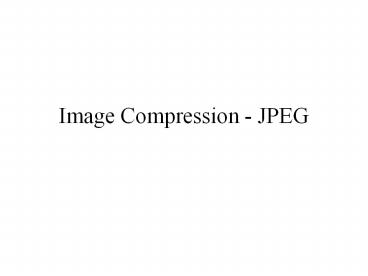Image Compression - JPEG - PowerPoint PPT Presentation
Title:
Image Compression - JPEG
Description:
Lossy / perceptually lossless / lossless. 3 layers ... Human perception properties. Human visual system {eye/brain} is more sensitive to some information as ... – PowerPoint PPT presentation
Number of Views:182
Avg rating:3.0/5.0
Title: Image Compression - JPEG
1
Image Compression - JPEG
2
Video Compression
- MPEG
- Audio compression
- Lossy / perceptually lossless / lossless
- 3 layers
- Models based on speech generation (throat), or
ear characterisitics - Image compression
- JPEG based
- Images take much more memory than voice
- An image is worth a thousand words
- Which thousand words?
- Video next week, can we extrapolate?
3
Image Compression Basics
- Model driven
- Reduce data redundancy
- Neighboring values on a line scan in an image
- DPCM, predictive coding
- Human perception properties
- Human visual system eye/brain is more sensitive
to some information as compared to others low
frequencies vs high frequencies be
careful..edges are often critical - Enhancement approaches
4
Entropy
- Entropy measurement of the uncertainty of the
input. Higher the uncertainty the higher the
entropy. - Which has higher entropy noise or a 300Hx sine
wave? - Computation is histogram based
- p(i) probability of occurrence of a gray level
in the image - E - Si p(i) lg p(i)
- Identifies the minimum number of bits required to
represent the image
5
Compression Issues
- Progressive display
- Display partially decompressed images
- User begins to see parts of the image, does not
have to wait for complete decompression - Hierarchical encoding
- Encode images at multiple resolution levels.
- Display images at lower resolution level and then
incrementally improve the quality - Asymmetry
- Time for encoding
- Time for decoding
6
Types of compression
- Lossless
- Huffman, LZW, Run length, DPCM?
- Typical compression 31
- Lossy
- Predictive
- Frequency based transform, subbands
- Spatial based filtering, non-linear
quantization, vector quantization - Hybrid
7
JPEG is based on
- Huffman coding
- Optimal entropy encoding
- Run length encoding
- Used in G3, fax
- Discrete Cosine Transform
- Frequency based
- Apply perception rules in the frequency domain
- The fidelity and level of compression can be
controlled 151 or even better
8
Huffman encoding
- Assign fewer bits to symbols pixel values that
occur more frequently - Number of bits per symbol is non-uniform
- The code book has to be made available to the
decoder, i.e. this file leads to increase in the
file size. - Results in optimal encoding
- Number of bits required is close to the entropy
9
Run length Encoding
- Run length, size, amplitude
- RL 4 bits
- Size 4 bits
- Amplitude 10 bits
- Maximum compression if the run lengths are long
- G3 used for fax
- Usually use Huffman to encode the parameters
10
Discrete Cosine Transform
- Real cousin of Fourier transform
- Complexity
- NN
- Fast DCT similar to FFT
- To reduce cost
- Divide image into 8 x 8 blocks
- Compute DCT of blocks
- Reduce the size of the object to be compressed
11
Quantization
- The eye is more sensitive to the lower
frequencies. - Divide each frequency component by a constant
- Divide higher frequency components with a larger
value - Truncate, and this will reduce the non-zero
values - Four quantization matrices are available in JPEG
12
Color
- RGB planes
- Transform RGB into YUV
- Y luminance
- U,V chrominance
- UV have lower spatial resolutions
- Down sampled to take advantage of lower resolution
13
Overview of JPEG
- RGB YUV
- Down sample UV
- Original data is 8 bits per pixel, all positive
0,255. Shift to -128, 127. - Divide image into 8x8 blocks
- DCT on each block
- Use quantization table to quantize values in each
block Reducing high freq content - Use zig-zag scanning to order values in each
block - Organize data into bands DC, low f, mid f, high
f - Run length encoding
- Huffman encoding
14
Reference
- G. K. Wallace, The JPEG Still Picture
Compression Standard, Communications of the ACM,
April 1991, vol 34, No. 4, pp 30 - 44
15
(No Transcript)
16
(No Transcript)































